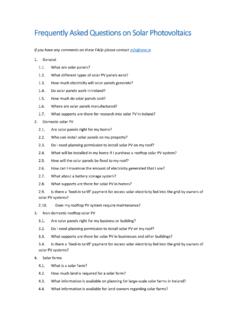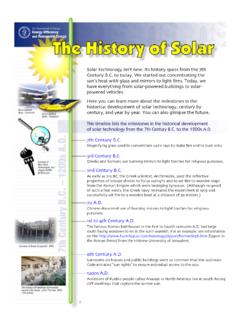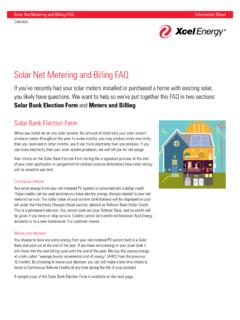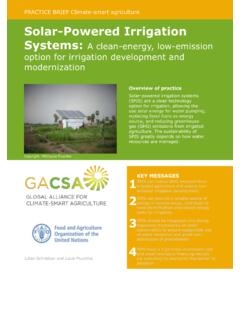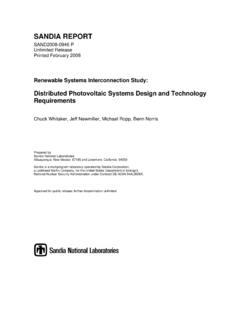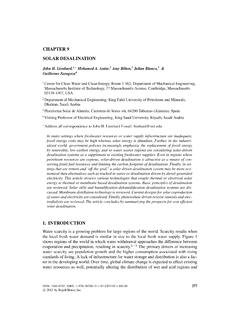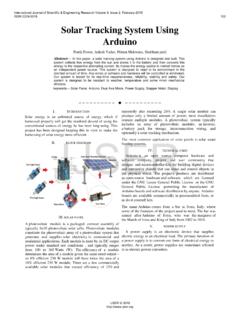Transcription of How to Calculate your Solar PV System
1 How to Calculate your Solar PV System System Size The size of a Solar electric System depends on the following: Daily Energy Usage: As you'd expect, the less energy you need, the less your System will cost. The average home in the and Puerto Rico uses more or less than 900 kW hours per month. Daily Sun Hours: This is the number of hours your location receives peak exposure to the sun. Normally most US states varies from 3 to 6 average hours per day. Puerto Rico sun hours are Percentage of Coverage: The cost of the System will depend on the percentage of electricity you hope to gain from Solar . Step 1: Learn Your Usage Determine your monthly usage from your electric bill, this is measured in kWh. If possible, review last twelve months of energy use and changes in energy behavior such as additional air conditioning units, heaters and added users in the family. Please note, the size of your home has nothing to do with the amount of power you consume.
2 PO Box 3062 Aguadilla, PR 00605. Step 2: Identify Energy Efficiency Opportunities Determine electrical efficiency opportunities that can lower your electrical bill. This can save significantly in your effort toward energy independence. Illumination: Change to Light emitting diodes (Leds) or compact fluorescent lights Water Heating: Change to High Efficiency Solar Water Heater Air Conditioning: Change to higher EER above 20 if possible There are many practices that can help save energy. See our Tips to Save Energy at Step 3: Find your Sun Hours Sun hours are an average amount of Solar hours if the sun were to produce 1000W/m 2 every hour. It ease energy analysis to size your System correctly. Puerto Rico sun hours are KW/m2, and it is an excellent location for Solar applications. See map for States average sun hours. Please to help you identify your sun hours in any other location.
3 Puerto Rico Sun hours is KW/ m2. Step 4: Calculate your System Decide which percentage from your total KWh/month from your electrical bill you want to reduce dependency. Remember you can save a lot by changing to more efficient appliances and lights. Solar technology is modular so you can stepwise built your System capacity according to your budget. 1. Use this formula to Calculate your PV System capacity. System KWh = KWh per month X Percentage of Coverage / System Efficiency where; Percentage of Coverage: percentage of electricity you hope to gain from Solar . System efficiency: end efficiency after accounting for all losses (normally near 80%). For a house consuming 600 KWh in Puerto Rico that wants 100% percentage of coverage to reach 100% electrical bill reduction, 600 KWh x 100%/80% = 750 KWh or 600 KWh x 1 / .80 = 750 KWh 2. Calculate your PV System capacity PV System = System KWh divided by 30 days and divided by location sun hours For Puerto Rico example, PV System =750/30 = KW.
4 PO Box 3062 Aguadilla, PR 00605. Step 5: Average System Cost The cost of a typical System can be broken down into 2 areas: components and installation. In the Solar industry, this cost is tracked by dollars per watt. Range of Cost: Residential Grid-Tie systems can start as low as $2000 (installed) for a starter System , all the way to $50,000 or more. Average Component Cost: $5 per watt. This includes all the components including panels, inverters, mountings and electrical accessories. Add $2 per watt for battery backup systems. Average Installation Cost: $2 per watt. This usually includes the physical installation of the System and connection to the grid. Example: For the example above kW Grid Tie System cost is near $22,600 and $9,041 for installation cost including design and permitting for a total of $31,645. Adding a battery backup System for emergency power can add additional $9,041 to your System for a total of $ Your System total price can vary as little as 10% more and as 20% less depending on various factors such as design, PV shadow, type of PV and price negotiations.
5 Therefore your System estimated range is 25,316 to $34,810 for Grid Tie PV Direct and $32,549 to $44,755 for a Grid Tie with battery backup. Your net price will reduce dramatically after rebates. Normally rebates are within 25% to 75% of your cost. In many cases, your payback can be achieved in less than 6 years. For example above with a 75% credit, your System final range cost is $6,329 to $8,702 for Grid Tie PV direct and for $8,137 to 11,188 for a Grid Tie with Battery Backup. What's Amazing: Just as you value purchasing your home and stop renting it, you also stop renting electricity and depending on fossil fuels cost increases. You also add near $40,000 of home increase value so your ROI is immediate positive. For the example above, you will eliminate 77506 lbs of CO2 per year which is equivalent to planting 112 trees every year. What's Next: 1. Continue educating yourself by reviewing our documents at Learn of 2.
6 To help you identify your needs, identify energy efficiencies at your property and help you define your System . 3. We'll help you identify your state rebates and credits to lower your System cost. 4. Purchase a System and start benefitting from this marvelous source of power, the sun. We invite you to visit our website and review this and other educational documents. Reasons to Go Solar Frequently Asked Questions Glossary of Terms Tips to Save Energy How Solar Photovoltaic Works LEED ership: Green Building PO Box 3062 Aguadilla, PR 00605.
